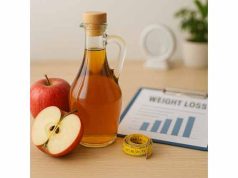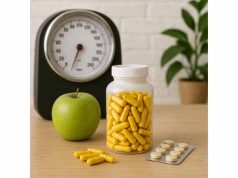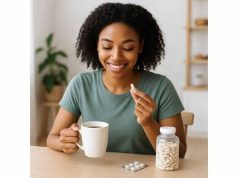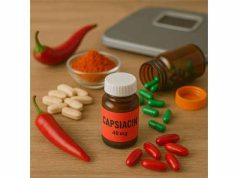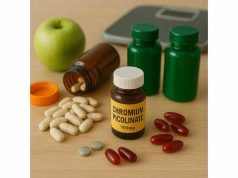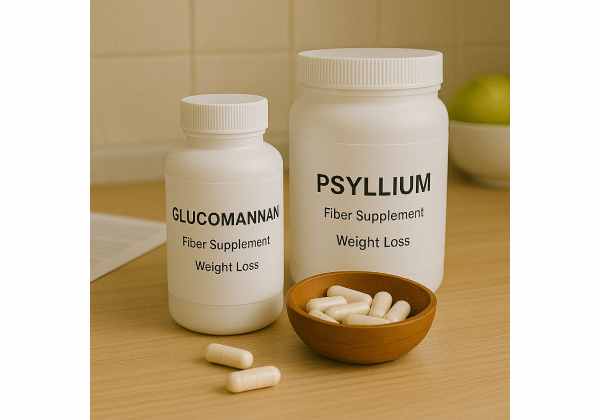
Many people turn to fiber supplements to curb hunger, stabilize appetite, and make calorie control easier. Two options dominate the conversation: glucomannan (from konjac root) and psyllium (from Plantago ovata husk). Both are soluble fibers that thicken with water, slow stomach emptying, and support more stable blood sugar—effects that can translate into eating less without feeling deprived. Yet they differ in viscosity, dosing, and digestive tolerance, so the “best” choice depends on your goals and stomach. This guide compares the two in plain language, outlines safe dosing and timing, and shows how to use fiber strategically within a complete plan. If you want to pair nutrition with proven therapies, review our overview of clinically supported treatments that can complement lifestyle change.
Table of Contents
- Do fiber supplements help with weight loss?
- Glucomannan vs. psyllium: what is different?
- How to dose glucomannan and psyllium safely
- Choosing forms and timing that work
- Common mistakes and troubleshooting
- Who should avoid or take extra care
- What the evidence says: results you can expect
- Frequently Asked Questions
Do fiber supplements help with weight loss?
“Help” is the operative word. Fiber supplements do not burn fat directly, but they can make a calorie deficit easier to maintain. Soluble fibers absorb water and create a viscous gel that:
- Delays gastric emptying so you feel full longer after meals.
- Blunts rapid rises in blood glucose and insulin that can trigger rebound hunger.
- Slightly reduces energy absorption by carrying a portion of dietary fat and carbohydrates further into the gut.
- Ferments in the colon, producing short-chain fatty acids that may enhance satiety signaling.
These effects are meaningful only when paired with consistent nutrition. The most durable outcomes show up when people combine fiber with daily protein targets, minimally processed foods, and regular activity. If those fundamentals are not in place, fiber becomes an expensive bandage.
How much difference can it make? For many people, an effective fiber routine reduces grazing and late-night snacking, trims portion sizes at meals, and smooths out cravings on a calorie-reduced plan. That may translate into several hundred fewer calories per week without feeling punished. Over months, that modest edge compounds.
Start with your base:
- A moderate calorie deficit (roughly 300–500 calories/day) rather than a crash diet.
- Protein at each meal (aim for 1.6–2.2 g/kg/day unless your clinician advises otherwise).
- Resistance training plus steps or low-intensity cardio to preserve muscle and mood.
If you need a refresher on the fundamentals, see our guide to safe, sustainable approaches to foundational habits that support weight loss. Once those are underway, fiber can be a practical add-on to improve adherence.
Bottom line: Fiber supplements can make weight management easier for many people by improving fullness and meal control. They are most effective when they support, not replace, a well-built plan.
Glucomannan vs. psyllium: what is different?
Glucomannan and psyllium share core benefits, but their properties lead to different real-world experiences. Understanding those differences helps you choose the right tool for your routine.
Where they come from and how they behave
- Glucomannan is a konjac-derived soluble fiber with exceptionally high viscosity per gram. It thickens quickly in water and expands significantly in the stomach. Because it is so water-hungry, relatively small doses can create strong fullness—but only when taken with ample liquid.
- Psyllium husk contains soluble arabinoxylans that gel more gradually. It still thickens in the stomach, but it is generally gentler on digestion and easier to dose flexibly, from small sips to larger servings.
Satiety and meal control
- Glucomannan can deliver pronounced fullness from surprisingly low doses (for many, 1 g before a meal is noticeable). That makes it appealing for people who struggle most with portion size at main meals.
- Psyllium tends to produce steadier appetite control across the day. It may not feel as dramatic, but many find it more predictable and better tolerated over weeks and months.
GI tolerance
- Glucomannan is more likely to cause early bloating if you jump to high doses. Because it expands rapidly, it must always be taken with plenty of water. People with a history of swallowing difficulties or GI narrowing should avoid it.
- Psyllium is often easier on the gut and may even improve stool form in both constipation and loose stools. Gas and bloating can occur if you increase dose too quickly.
Blood glucose effects
- Both fibers can blunt post-meal glucose spikes. Psyllium’s slower gel formation sometimes makes it a better companion for carbohydrate-rich meals; glucomannan’s rapid thickening is more “front-loaded” to reduce early gastric emptying.
Practicality and products
- Glucomannan is commonly sold as capsules or small-volume drink mixes. Capsules are convenient, but you still need a large glass of water with each serving.
- Psyllium is widely available as powders and capsules. Powders are cost-effective and easy to tailor to the teaspoon.
When in doubt, match your choice to your sticking points: use glucomannan if dinner portions are your main hurdle and you can commit to careful water intake; choose psyllium if you want steady appetite support, smoother digestion, and flexible dosing. As you compare labels and doses, it helps to know how to interpret claims—see our quick primer on reading supplement labels so you can spot meaningful amounts.
How to dose glucomannan and psyllium safely
Getting the dose and timing right maximizes benefits and minimizes side effects. Use the ranges below as starting points, then adjust based on tolerance and meal patterns.
General rules for both fibers
- Start low, go slow. Begin with one small daily serving for 3–4 days, then add a second if needed.
- Always take with water. A good rule is at least 240–500 ml (8–16 oz) of water per serving. More is better with glucomannan.
- Time it before food. Take fiber 15–30 minutes before meals so the gel forms in the stomach ahead of eating.
- Separate from medications. To reduce the risk of impaired absorption, take prescription drugs and fat-soluble supplements at least 2–3 hours apart (ask your clinician for personalized guidance).
Glucomannan dosing
- Entry dose: 500 mg once daily before the largest meal for 3–4 days.
- Typical target: 1,000 mg before 1–2 meals per day (1–2 g/day total).
- Upper end (experienced users): Up to 3,000 mg/day in divided doses, with careful hydration and medical clearance if you take medications that must be precisely absorbed.
- Water requirement: Do not swallow dry powder; take capsules with a full glass of water and remain upright for 30 minutes.
Psyllium dosing
- Entry dose: 1 level teaspoon (about 2–3 g husk powder) once daily mixed in water.
- Typical target: 3–5 g before 1–2 meals per day (3–10 g/day total).
- Upper end (experienced users): Some people tolerate 10–15 g/day in divided doses for appetite and stool normalization.
- Mixing tip: Stir briskly and drink soon after mixing; follow with another half-glass of water to clear residue.
When to adjust
- If you feel uncomfortably full during meals: Reduce pre-meal dose or take fiber earlier (30–40 minutes before).
- If you get late-night hunger: Shift one serving to the afternoon snack window.
- If you experience gas or cramping: Back down to the previous well-tolerated dose for several days, increase fluids, and rebuild gradually.
Quality matters
Choose products with clear per-serving fiber grams, minimal sweeteners, and verified purity. Independent certification lowers the risk of contamination and mislabeled doses; look for marks from reputable testing programs such as those explained in our overview of third-party testing.
Choosing forms and timing that work
Your best fiber routine is the one you can repeat daily. Match form and schedule to your habits rather than forcing a plan that falls apart after a week.
Capsules vs. powders
- Capsules are portable and simple but limit dose flexibility. With glucomannan especially, capsules require a full glass of water. They are useful for targeted pre-meal fullness when you are away from home.
- Powders are economical, easy to titrate, and mix into water, yogurt, or warm cereal. Psyllium powder thickens quickly; stir and drink promptly.
When to take
- Before the hungriest meals. If dinner is your challenge, place one serving 20–30 minutes before it. If afternoon grazing derails you, try a serving before lunch.
- Around training. Avoid taking fiber immediately before intense workouts; fullness can feel heavy. A morning dose and an evening dose work well for many people.
What to mix with
- Plain water is the baseline for predictable effects.
- Yogurt or overnight oats can turn fiber into a higher-protein snack.
- Shakes are convenient when you are rushing; just ensure enough total liquid and drink promptly to avoid over-thickening. For shake strategy and protein selection, see our guide to practical protein shakes.
Food first still applies
If you consistently fall short of 25–38 g/day of total dietary fiber (typical adult targets), start with food: legumes, oats, barley, chia, flax, fruits, and vegetables. A supplement is most useful to fill timing gaps around key meals, not to replace fiber-rich foods that deliver micronutrients and texture.
Travel and busy weeks
Pre-portion powder into small containers or carry a blister strip of capsules. Keep a collapsible bottle on hand so you can reliably hit the water requirement.
Common mistakes and troubleshooting
Most fiber frustrations come from dose jumps, poor hydration, or mismatched timing. Use these fixes to turn a rough start into a workable routine.
Mistake 1: Starting high and blaming your gut
Jumping straight to multi-gram doses invites gas, cramping, and bloat. Solution: step up slowly and hold each increase for several days before adding more.
Mistake 2: Skimping on water
Glucomannan and psyllium both need water to form a safe gel. Too little liquid can cause discomfort and, with glucomannan, rare choking risk. Set a rule: full glass with the dose, half a glass afterward.
Mistake 3: Taking fiber right before bed
Late-night doses can cause reflux-like fullness. Place your last serving with dinner and remain upright for at least 30 minutes.
Mistake 4: Expecting fat loss without diet structure
Fiber improves satiety; it does not erase the impact of energy-dense snacks or sugary drinks. Replace a 12-ounce soda with sparkling water and a fiber-rich snack to remove ~140 calories while adding fullness.
Mistake 5: Confusing laxatives with weight loss
“Detox” teas and stimulant laxatives lead to water and stool loss, not fat loss—and can disrupt electrolytes. If you have been using purgatives to “kick-start” a cut, read our cautionary overview on laxative products and risks.
Mistake 6: Ignoring medication timing
Psyllium and glucomannan can reduce absorption of certain drugs (e.g., levothyroxine, some diabetes and seizure medications). Keep a 2–3 hour buffer, and confirm with your clinician.
Mistake 7: Quitting too early
Many people acclimate within 7–10 days. If mild gas is the only issue, pause dose increases, increase fluids, and add a brief walk after meals.
Who should avoid or take extra care
Fiber is broadly safe, but certain situations call for caution or medical supervision.
Avoid glucomannan or psyllium if you:
- Have known esophageal or intestinal strictures, swallowing difficulties, or prior bowel obstruction.
- Have a history of severe allergic reactions to Plantago (for psyllium) or konjac products.
- Cannot reliably meet the water requirement with each dose.
Use medical guidance if you:
- Take medications that require consistent absorption (e.g., levothyroxine, carbamazepine, certain antidepressants, some diabetes medications). Your clinician may advise specific timing or monitoring.
- Live with significant GI disease (IBD flare, active diverticulitis) or have had recent GI surgery.
- Are pregnant or breastfeeding. Many clinicians allow psyllium for constipation, but confirm dose and timing for appetite uses.
- Are underweight, recovering from an eating disorder, or have a history of binge-restrict cycles; satiety manipulation can complicate care.
Signs to stop and seek help
- Persistent chest pain, difficulty swallowing, or vomiting soon after a dose.
- Severe abdominal pain, blood in stool, or signs of dehydration.
- New medication side effects that began after starting fiber.
If lifestyle measures are in place and your weight remains medically concerning, consider a broader plan with your healthcare team. Our plain-English primer on weight-loss medications explains who may qualify and how these therapies fit with nutrition and activity.
What the evidence says: results you can expect
No single number captures everyone’s response, but patterns emerge across controlled trials and real-world use.
Magnitude of effect
- When added to a calorie-reduced diet, glucomannan at 1–3 g/day often yields modest extra weight loss over 8–12 weeks for people who tolerate it—largely via reduced intake at meals.
- Psyllium at 5–10 g/day tends to deliver steadier appetite control, modest weight loss, and improvements in LDL cholesterol and glycemic responses. It may shine for people with mixed digestive complaints.
Speed and durability
- Expect appetite changes within a few days and measurable changes on the scale within 2–4 weeks if total calorie intake declines. The most durable results arise from consistent routines rather than short bursts of high doses.
- Benefits can plateau as your body adapts. That is not failure—it is a signal to reassess meal composition, protein targets, and activity rather than chasing bigger fiber doses.
Who tends to benefit most
- People with strong evening appetite, frequent snacking, or large portion sizes.
- Those who struggle to meet daily fiber targets from food alone.
- Individuals who value a simple, low-cost tool they can attach to existing meals.
What success looks like in practice
- A small, sustainable daily calorie reduction enabled by fewer unplanned snacks or slightly smaller portions.
- Improved regularity and stool form (especially with psyllium), better post-meal energy, and less “hangry” decision-making.
- A gradual, realistic weight trend when combined with protein, resistance training, and adequate sleep.
Remember, fiber supplements are supporting actors. Use them to make the right choice the easy choice—then let consistency do the heavy lifting.
Frequently Asked Questions
Is glucomannan or psyllium better for weight loss?
Glucomannan is more viscous per gram and can deliver stronger pre-meal fullness at lower doses, while psyllium offers steadier appetite control and gentler digestion. Choose glucomannan if large portions are your main hurdle; choose psyllium for day-long consistency and better stool regularity.
How much water should I drink with fiber supplements?
Aim for at least 240–500 ml (8–16 oz) of water with every serving. Glucomannan is especially water-hungry. Drink promptly after mixing, follow with extra sips, and remain upright for 30 minutes to reduce choking risk and improve comfort.
When should I take glucomannan or psyllium for best results?
Take a serving 15–30 minutes before meals you tend to overeat. If afternoon grazing is the issue, place a dose before lunch. Avoid doses right before intense workouts or bedtime to prevent heavy fullness and reflux-like discomfort.
Can fiber supplements interfere with medications?
Yes. Both fibers can reduce or delay absorption of some drugs. Separate doses of levothyroxine, certain diabetes medications, and other sensitive prescriptions by 2–3 hours. Ask your clinician or pharmacist for individualized timing advice.
What side effects should I expect at first?
Temporary gas, bloating, or a heavier stomach are common when doses increase too quickly. Start low, build gradually, and increase fluids. Stop and seek care if you experience chest pain, difficulty swallowing, persistent vomiting, or severe abdominal pain.
Do I still need to eat high-fiber foods if I use supplements?
Yes. Whole foods supply micronutrients, texture, and diverse fibers your microbiome thrives on. Use supplements to fill timing gaps—especially before challenging meals—while aiming for 25–38 g/day of total dietary fiber from foods.
References
- Psyllium is a natural nonfermented gel-forming fiber that is effective for weight loss: A comprehensive review and meta-analysis 2023 (Systematic Review & Meta-analysis)
- The effect of psyllium on fasting blood sugar, HbA1c, HOMA IR, and insulin control: a GRADE-assessed systematic review and meta-analysis of randomized controlled trials 2024 (Systematic Review & Meta-analysis)
- The effect of Glucomannan on fasting and postprandial blood glucose in adults: a systematic review and meta-analysis of randomized controlled trials 2022 (Systematic Review & Meta-analysis)
- The role and therapeutic effectiveness of Plantago ovata husk (psyllium husk) in the prevention and non-pharmacological treatment of gastrointestinal diseases. Part 2. Clinical use of psyllium husk in the treatment of constipation and diarrhea 2024 (Review/Clinical Guidance)
- Laxative Drug Products for Over-the-Counter Human Use; Psyllium Ingredients in Granular Dosage Forms 2007 (Safety/Regulatory)
Disclaimer
This article is for educational purposes and is not a substitute for personalized medical advice, diagnosis, or treatment. Always consult a qualified healthcare professional before starting or changing supplements, especially if you take prescription medications, are pregnant or breastfeeding, or have digestive or metabolic conditions.
Share and follow
If this guide helped you compare glucomannan and psyllium, consider sharing it with someone planning their next steps. For practical updates and tools you can use, follow us on your preferred social platform—Facebook, X, or wherever you spend time. Your questions and feedback are welcome.

